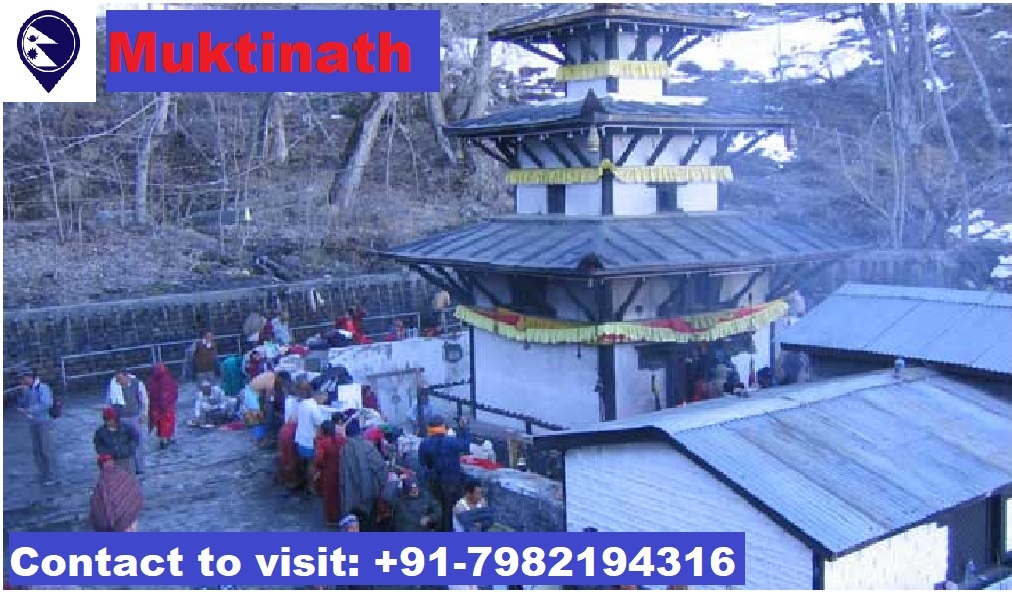Muktinath Temple, also known as Chumig Gyatsa, is considered a symbol of the religious symbiosis between Hindus and Buddhists. It is believed by Hindus that Lord Vishnu attained salvation from the curse of Brinda (wife of Jalandhar) at this site, which is why he is worshipped as Muktinath, meaning “the lord of salvation.” This holy shrine, which is said to have arisen on its own, is one of eight such shrines, with the others including Srirangam, Sri Mushnam, Tirupati, Naimisaranyam, Thottadri, Pushkaram, and Badrinath. Additionally, this pagoda-style Muktinath Temple is one of the 108 Vaishnava shrines. During the early 19th century, Hindus consecrated a Vishnu temple here, naming it Muktinath – Lord of Liberation. With a backdrop of stark beauty, one can gaze southward at the snow-covered Annapurna range or northward towards the Tibetan plateau.

Muktinath Temple
Current Status of Muktinath Temple
As of now, Shree Muktinath Temple has been reopened for visitors. Operations were resumed in October 2021, following specific criteria. Visitors must now present a COVID-19 PCR negative report (taken within 72 hours) or a COVID-19 Vaccination Card to enter Mustang District. Those failing to provide these documents will be turned away at the Beni Check Post. The temple had been closed for six months to control the second wave of the COVID-19 virus.
Meaning of Muktinath
The word “Muktinath” is derived from “Mukti” and “Nath.” “Mukti” means “salvation or nirvana,” and “Nath” means “god or master.” The concept of Mukti holds great significance for all spiritual people in the South Asian subcontinent. The Sanskrit name “Muktinath” itself carries religious overtones and emotional resonance for devout Hindus.
Importance of Visiting Muktinath Temple
According to Hindu belief, this world is an illusion (“MAYA”), part of the cycle of birth and rebirth. Everyone seeks to escape this cycle and achieve nirvana. A visit to Muktinath is believed to help achieve this goal. The temple features 108 waterspouts called Muktidhara and two Kunda (ponds) in front of the temple. Bathing in these waterspouts and ponds is believed to bring salvation.
Location of Muktinath Temple
Muktinath Temple is located at an altitude of 3710 meters above sea level, situated 24 km northeast of Jomsom in the Mustang district of Nepal. The temple can also be reached after crossing the Thorong-La mountain pass in the Annapurna Conservation Area. It is part of the famous trekking route “Annapurna Circuit.”
Muktinath Travel Guide
Option 1: By Road (2 nights)
Muktinath Temple can be accessed by road from Kathmandu to Pokhara via the Prithvi Highway, continuing through Beni, Tatopani, Ghasa, Marpha, Jomsom, and Kagbeni.
- First Halt: The journey begins from Kathmandu to Pokhara, covering 206 km and taking about 7 hours. Pokhara, at an altitude of 910 meters, offers various accommodations and facilities. It can also be reached via a 25-minute flight from Kathmandu.
- Second Halt: The road from Pokhara to Jomsom, 170 km away, includes 100 km of blacktop road to Beni and 70 km of off-road to Jomsom. This journey takes about 8-9 hours. Jomsom is also accessible by a 15-minute flight from Pokhara. From Jomsom, a 25-minute walk and a 1.5-hour jeep ride are required to reach Muktinath Temple.
Option 2: By Flight (1 night)
Jomsom, the nearest airport to Muktinath , can be reached via a flight from Kathmandu to Pokhara, followed by a flight from Pokhara to Jomsom. Flights to Jomsom operate only in the early morning due to windy conditions, necessitating a one-night stay in Pokhara.
Option 3: By Helicopter (1.5 hours)
Muktinath Temple can be visited by a helicopter tour from Kathmandu, which takes about one and a half hours. The helipad is located at Ranipauwa, from where the temple is a 30-minute walk.
Option 4: By Trek (7 nights)
An adventurous trek to Muktinath Temple starts from Nayapul (1-hour drive from Pokhara), with overnight stays at Tikhedunga, Ghorepani, Tatopani, Ghasa, Marpha, and Kagbeni before reaching Muktinath.
Required Permits
Two permits are required to visit Muktinath Temple: the Annapurna Conservation Area Project Permit (ACAP) and the Trekker’s Information Management System Permit (TIMS). Entry into this zone is restricted without these permits.
Best Time to Visit
The best months to visit Muktinath are March, April, May, June, September, October, and November. During these months, the weather is clear, and the snowcapped mountains are visible.
Muktinath Temple After the Earthquake
The April 2015 earthquake in Nepal did not affect Muktinath Temple. It remains safe and secure to visit. While the Gorkha, Kathmandu, Langtang, and Everest regions were damaged, all places are now safe to visit.
For Further Information
Nepal Tour Package provides the best tour packages for the travel lovers of each type, whether it is Adventure Tour, Spiritual Tour, Beach Tour, Family Tour, Heritage Tour, Holiday Tour & Wildlife Tour.
For more information call our tour experts: +91 –7982194316
Get the best Holiday Offers
Email Us at :- info@nepaltpurpackages.com




